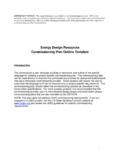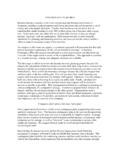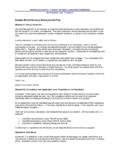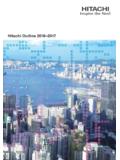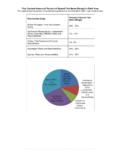Transcription of Hazardous Waste Management (RCRA *) Compliance Plan
1 Connecticut Department of Energy & Environmental Protection Bureau of Materials Management and Compliance Assurance Waste Engineering and Enforcement Division Hazardous Waste Management (RCRA*) Compliance plan General Business Information Facility name: Facility address: US EPA Identification Number: Type of activities performed: plan date/Date of last revision: Purpose of this plan The purpose of this plan is to outline the requirements for managing Hazardous Waste at this facility. This plan should also be used to supplement employee training and should be provided to all employees who have Waste Management responsibilities, as well as being readily available on the facility floor.
2 This plan is not a complete compilation of regulatory guidance, nor is it a substitute for state or federal regulations. This plan is a facility-specific guide to Hazardous Waste Management procedures that are compliant with Connecticut s Hazardous Waste Management Regulations. Connecticut s Hazardous Waste Management Regulations are codified in Sections 22a-449 (c)-100 through 119 and 22a-449(c)-11 of the Regulations of Connecticut State Agencies (RCSA). The Connecticut Hazardous Waste Management Regulations incorporate by reference the federal Hazardous Waste Management regulations found in Title 40, Parts 260 through 279 of the Code of Federal Regulations (CFR) with certain changes.
3 This plan is maintained by the following personnel: Frequency at which this plan will be reviewed and updated: The following personnel have Hazardous Waste Management responsibilities and are familiar with this plan : * RCRA is the federal Resource Conservation and Recovery Act, the federal law that sets standards to ensure that Hazardous wastes are stored, handled, recycled and disposed of safely. 79 Elm Street Hartford, CT 06106-5127 Page 1 Hazardous Waste Management (RCRA) Compliance plan Hazardous Waste Determinations A Hazardous Waste determination is a procedure used to determine whether a solid Waste is a Hazardous Waste .
4 Any person who generates solid Waste must determine if that Waste is a Hazardous Waste . Generators are responsible for making Hazardous Waste determinations. Hazardous Waste determinations must be updated every 12 months and whenever the process generating a Waste changes. Documentation of such determinations must be retained in the facility s operating records. The first step in this process is to make a list of all the solid wastes generated at your facility. RCRA defines a solid Waste as: "Any garbage, refuse, sludge from a wastewater treatment plant, water supply treatment plant, or air pollution control facility, and other discarded material, resulting from industrial, commercial, mining, and agricultural operations and from community activities.
5 " These wastes include manufacturing and process wastes, maintenance wastes, wastewater treatment sludge, wastes generated by air pollution control equipment, unwanted or expired commercial chemical products, and spent fluorescent lamps, batteries, and electronics. Then use the Hazardous Waste Determination Summary Sheet to determine which of these wastes are Hazardous and to document certain information about each Waste . This facility generates the following wastes*: Point of Waste Generation Waste Description Hazardous ? Non- Hazardous ? Waste Code(s) *Attach additional sheets as needed.
6 Hazardous Waste determinations must be made and maintained for each of these wastes. Who is responsible for updating Hazardous Waste determinations at this facility? Where are Hazardous Waste determinations kept? Page 2 Hazardous Waste Management (RCRA) Compliance plan Identify Hazardous Waste Generator Category It is important to correctly determine your facility s Hazardous Waste generator category because different sets of regulatory requirements apply to each of the generator categories, with Large Quantity Generators of Hazardous Waste having the most requirements, and Conditionally Exempt Small Quantity Generators the fewest.
7 To determine this facility s generator category, use your Hazardous Waste determinations to complete the Hazardous Waste Generator Category Worksheet. For information regarding each generator category, review the Determining Hazardous Waste Generator Category fact sheet. This facility s Hazardous Waste generator category is: Conditionally-Exempt Small Quantity Generator Small Quantity Generator Large Quantity Generator The maximum amount of Waste generated per calendar month as allowed by this category is: No more than 100 kg AND no more than 1 kg acute wastes.
8 Between 100 and 1,000 kg AND no more than 1 kg acute wastes. 1,000 kg or more OR more than 1 kg acute wastes. The maximum amount of Waste stored on-site at any one time as allowed by this category is: No more than 1,000 kg AND no more than 1 kg acute wastes. More than 1,000 kg OR more than 1 kg acute wastes. Waste must be sent off-site for proper disposal within the following number days from the date of generation: (LQG Required) 90 (SQG Required) 180 (CESQG) Not applicable no time limit applies If this facility exceeds its allowable generation rate in a calendar month due to a unique occurrence or an unforeseeable/infrequent event, it must comply with the more stringent regulations associated with the higher generator category during the occurrence/event.
9 If the exceedence becomes routine or is the result of a recurring event, the facility must re-evaluate its generator category and notify the Department of Energy and Environmental Protection (DEEP) of its new category by completing and submitting EPA Form 8700-12 to: Connecticut Department of Energy and Environmental Protection Bureau of Materials Management and Compliance Assurance Waste Engineering and Enforcement Division 79 Elm Street, 4th Floor Hartford, CT 06106-5127 Page 3 Hazardous Waste Management (RCRA) Compliance plan Waste Minimization Waste minimization is the most effective strategy for reducing the amount of Hazardous Waste a facility generates.
10 A few ways to accomplish this include purchasing raw materials in the smallest practical size and quantity, avoiding overstocking material, and replacing toxic materials with non-toxic materials. This facility minimizes its Waste by: Substituting raw materials for less Hazardous alternatives: Yes No If yes, provide a detailed description: Reducing water usage: Yes No If yes, provide a detailed description: Implementing energy efficiency initiatives: Yes No If yes, provide a detailed description: Using closed loop processes: Yes No If yes, provide a detailed description: Other: Yes No If yes, provide a detailed description.











